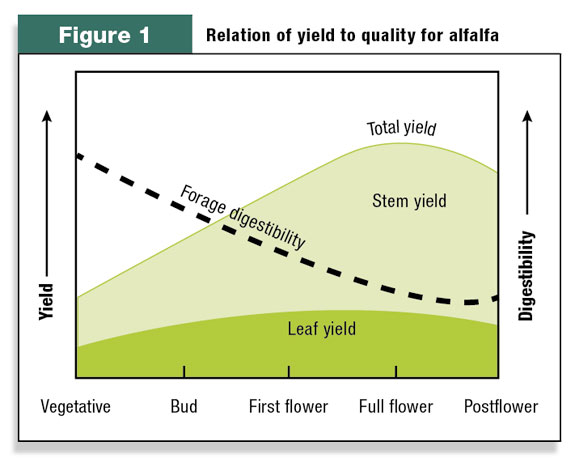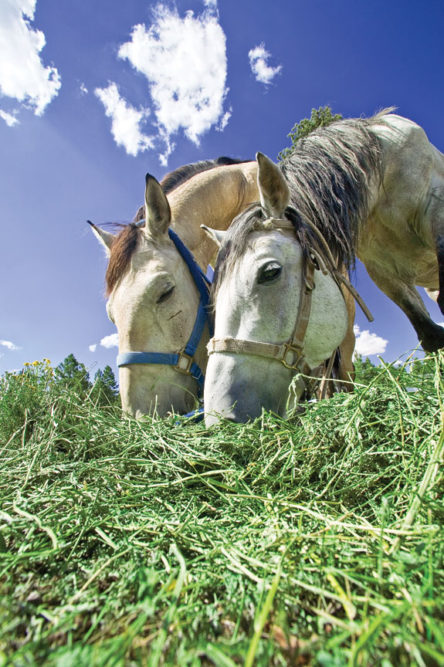A University of Idaho study looked at a relative cost comparison on two factors, total digestible nutrients (TDN) and crude protein (CP).
To accomplish this, a comparison based on relative feed value (RFV) using the price of premium hay as the base value was developed using the alfalfa hay test guidelines cited in the USDA-AMS Idaho Weekly Hay Market News report.
Using the methodology developed, hay growers and buyers can assess relative values of feed and compare per-unit cost for protein and nutrient value.
The study shows these values have fluctuated on a year-to-year basis, with the relative prices for CP or TDN changing over time.
One interesting item that came out of this was the very narrow price premium using the RFV-based prices for supreme hay over premium hay.
Thus another question arises, is it worth a grower’s extra efforts to obtain supreme hay?
Looking at pricing differences
Our initial action was to develop a way to compare equivalent prices for hay based on relative feed value (RFV) using the price of premium hay as a base.
- Step 1
Develop an RFV index to express the amount of RFV of each hay grade relative to a base hay grade. We used premium-quality hay as the base.
Divide RFV of each grade of hay by the RFV of the base hay (premium) to develop the RFV index to express the RFV in comparison to the base.
Examples:
Supreme RFV is 185 and the premium RFV is 170. Consequently, ((185/170) * 100) gives a “RFV ratio” of supreme-to-premium of 108.
The RFV ratio of premium-to-premium is ((170/170) * 100) or 100. Likewise, good-to-premium would be ((150/170)*100) 88 and fair-to-premium is ((130/170)*100) 76.5.
- Step 2
Once the index is developed for each quality, we evaluate the price relative to the RFV index by dividing price by the RFV index value associated with that price.
This places the price of all hay qualities on the same basis as premium hay for an easy comparison of hay price on a relative basis.
Examples:
A supreme hay price of $93.71 per ton in 1999, divided by an RFV Index of supreme-quality hay (108) gives ((93.71/108)*100) = $86.77, which can be compared directly to the 1999 premium hay price of $79.71.

Given that good-quality hay averaged $66.83 per ton in 1999, a premium equivalent price would be ((66.83/88)*100) or $75.94. Therefore, given the RFV of each quality and hay, buyers underpaid for supreme-quality hay by $7.06 per ton and overpaid for good-quality and fair-quality hay (Table 1).

Yield versus quality
There is a trade-off between yield and quality (Figure 1) of alfalfa, as with most forage. Alfalfa in the vegetative to early bud stages will have higher RFV but yield less per acre.
Growth is influenced by weather and growing degrees. Alfalfa can increase by 80 pounds per acre per day in May, but by 110 pounds per acre per day or more in July.
The management thus involves close monitoring of hay growth to optimize cutting timing and harvest intervals.
At the same time as tonnage is increasing, RFV may decline by 3 to 7 points per day. The number and timing of cuttings will also influence stand persistence.
A comparison between a three-cutting system, premium-quality and seven-ton total yield to a four-cutting system, supreme-quality and 6.5-ton yield shows the differences.
Results
Both the price of hay and the number of acres harvested have remained fairly stable over the last 20 years in Idaho.
Total acres harvested have fluctuated between 900 thousand and 1.2 million acres over the time period considered.
Price had remained quite stable in the $80 to $100 dollar per ton range until 2007, when the price of alfalfa hay began to skyrocket (Table 2).
By 2008, the price of hay in Idaho had peaked in excess of $200 per ton and by 2009 hay prices had once again come into check at values of $115 dollars per ton.
Recently prices have been increasing again as high prices for alternative crops like corn and grains bid for hay acres.
There is a significant price incentive for producers to achieve premium quality over good-quality hay.
From 1999 to 2010, the average market price differential between premium-quality hay and good-quality hay was $16.94 per ton, with the minimum market price differential consistently exceeding $8 per ton.
By meeting premium-quality standards, producers can ensure a healthy return for management effort.
On average for years 1999 through 2010 (with available data) on the RFV price basis, premium-quality hay earned $113.31 per ton, while supreme earned $115.77 per ton.
This may suggest that producers consider focusing their efforts on achieving a crop that meets premium-quality standards.
The years and data in this study illustrate that supreme-quality hay may not yield great enough returns to outweigh the additional managerial efforts required to produce it.
The average RFV price differential from 1999 to 2010 between supreme-quality hay and premium was just $2.47 per ton. Further, when differences in yield and harvest costs are considered, the net gain for supreme versus premium hay is negligible to possibly even negative (Table 3).
Conclusions
When choosing among feed alternatives, take a few minutes to do a rough calculation to determine costs on a dollar-per-nutrient-basis.
This can save a costly mistake especially with regard to increasingly popular alternative feeds that may seem like a good deal on the surface. A quick investigation can yield much better decision-making criteria.
There is a significant price incentive for producers to achieve premium-quality over good-quality hay. By meeting premium-quality standards producers can ensure a healthy return for management effort.
There is a price incentive to produce premium-quality over supreme-quality as the market exists currently.
When pricing is placed on a nutritional basis using RFVs and premium as the basis, the additional value in supreme-quality hay is often negligible to less than that received for premium-quality hay.
This could change if the market offers more value for the higher RFV in supreme-quality hay. FG
C. Wilson Gray is a District Extension Economist, Twin Falls Research & Education Center, University of Idaho. Gina Greenway is a Research Associate in and graduate of the Agricultural Economics and Rural Sociology Department, University of Idaho.
References omitted due to space but are available upon request.

Wilson Gray
Extension Economist
University of Idaho Extension












